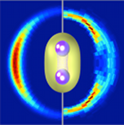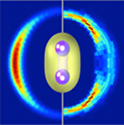Ordering in hydrogen under high pressure
The behavior of hydrogen under pressure affects fields ranging from condensed matter physics to astrophysics. Compressed liquid hydrogen exhibits a molecular-to-atomic transition. However, despite several experiments, the theoretical debate on the nature of this transition, in particular whether it is a continuous or discontinuous (first-order) transition, has not yet been settled.
In an article in Physical Review Letters, Isaac Tamblyn and Stanimir Bonev of Dalhousie University in Nova Scotia, Canada, employ molecular dynamics to map the phase diagram of dense hydrogen over a large range of temperatures and pressures. Their findings suggest an unreported phase in the liquid with short-ranged orientational order, resulting from a transition that they predict should occur in the liquid above . This new phase may explain certain characteristics of the molecular-to-atomic transition, the shape of the melting line, as well as the structure of hydrogen mixtures. The authors argue that a first-order transition is likely, and the new insight provided should spur future experimental work. – Sami Mitra





